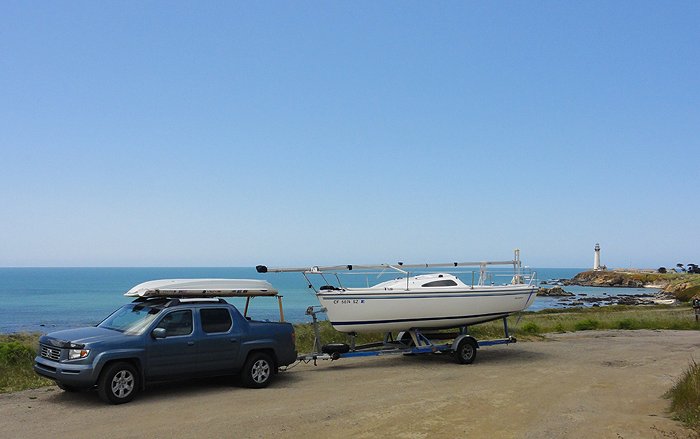If we are speaking theory, and we are building a new sailboat, how about we step back a few years and see what designers, respected designers, were building in the heyday of small sailboat yachts in California. The 1970's. I know more about William Crealock than other designers, as I own two of his designs, so I will speak about his goals for the largest trailerable sailboats of his time, the CM30, and CM32. Bill Crealock is universally recognized as one of the best blue water sailboat designers.
A trailer sailboat maker, Clipper Marine of southern California, and Mexico, commissioned Bill Crealock to design a sailboat with five main goals. Safety, transportability, speed, cruising comforts, and affordable. Bill was up to the challenge, and designed sailboats from 21 feet to 32 feet, and within the specifications goals.
One of the neatest design aspects of his larger CM models, was an enclosed engine well, that housed an off the shelf two stroke 9.9 to 15 hp outboard. While sailing, the engine could be raised to give the boat the best lines through the water. The sailboats looked great, because no unsightly outboard was sticking out of the stern, they were completely hidden from view He also used Yanmar diesel engines as inboards if the customer ordered it that way, in 8, 12 and 20 hp.
His designs were also quick for his time, with most having a hull speed of about 7 knots. My CM32 has a hull speed of 7.34.
Where any designer runs into grief later, is trying to balance, great looks, while trying to keep down costs. Gel coat over fiberglass is much more cost effective than Exotic marine woods, but over time, when one builds to serve economy, later criticisms show up, saying boats were poorly made. Polished interior gelcoat is not for the limousine jet set, however, that design feature does last the test of time quite well, and is easy to maintain at a new sailboat condition, somethings woods seldom do, with continual Maintance
If I were going to build a sailboat today, I would do two models as knock offs from Bill Crealock concepts, with a couple modern twists. I would have a beam of 8.5' rather than the 8.0' he used, and I would update the stern to an easy to use sugar scoop design. I would sell a 28 and a 35, using his designs from his 26 and 32.
I would keep them trailerable, light and strong with carbon fiber as well as fiberglass. The 35 would be offered, as before in sloop and ketch designs, except I would offer the ketch, as a cutter ketch with a bow spirit rather than a smaller bow pulpit. Two cockpit designs would be used again, center cockpit, and stern cockpit. Center cockpit models would come with a separate companionway aft owners cabin.
The business partner of Bill Crealock is still alive, still designing boats in southern California. Would not be impossible for this guy to get involved in a latter day revamp of a very successful sailboat line.
Want to get fanciful in this sailboat design? Modern? High tech?
Sell a 35 with two matching jet skis. All electronically matched. From the cockpit of the sailboat, your jet skis are 100% controllable On docking, the jet skis attach themselves with auto locks, so your sailboat is guided into your slip like miniature tug boats. On the lake, the jet skis could be programed to circle you, throwing rooster tails, or they could automatically follow your course for an entourage fore and aft. The jet skis could also be used for guests and family to play on. Keeping the beam narrow, two also narrow jet skis on each side of the sailboat, would still fit in most slips designed for 35 feet long sailboats. Too narrow of a slip, no problem, have one automatically disengage and lock on to double up on one side when slipped. This idea would lend itself well for folks using mooring balls. With a remote control, one ot two jet skis disembark, and meet you at the docks.
The jet skis could be left in place, for times you want more stability on the sailboat. Less heeling, or partying in a cove.
Want to win that race? Add 10% thrust. Who would know back at the marina? Lol
Attached jet skis have been done on powerboats, but not on sailboats, to my knowledge. A triskismaran.












